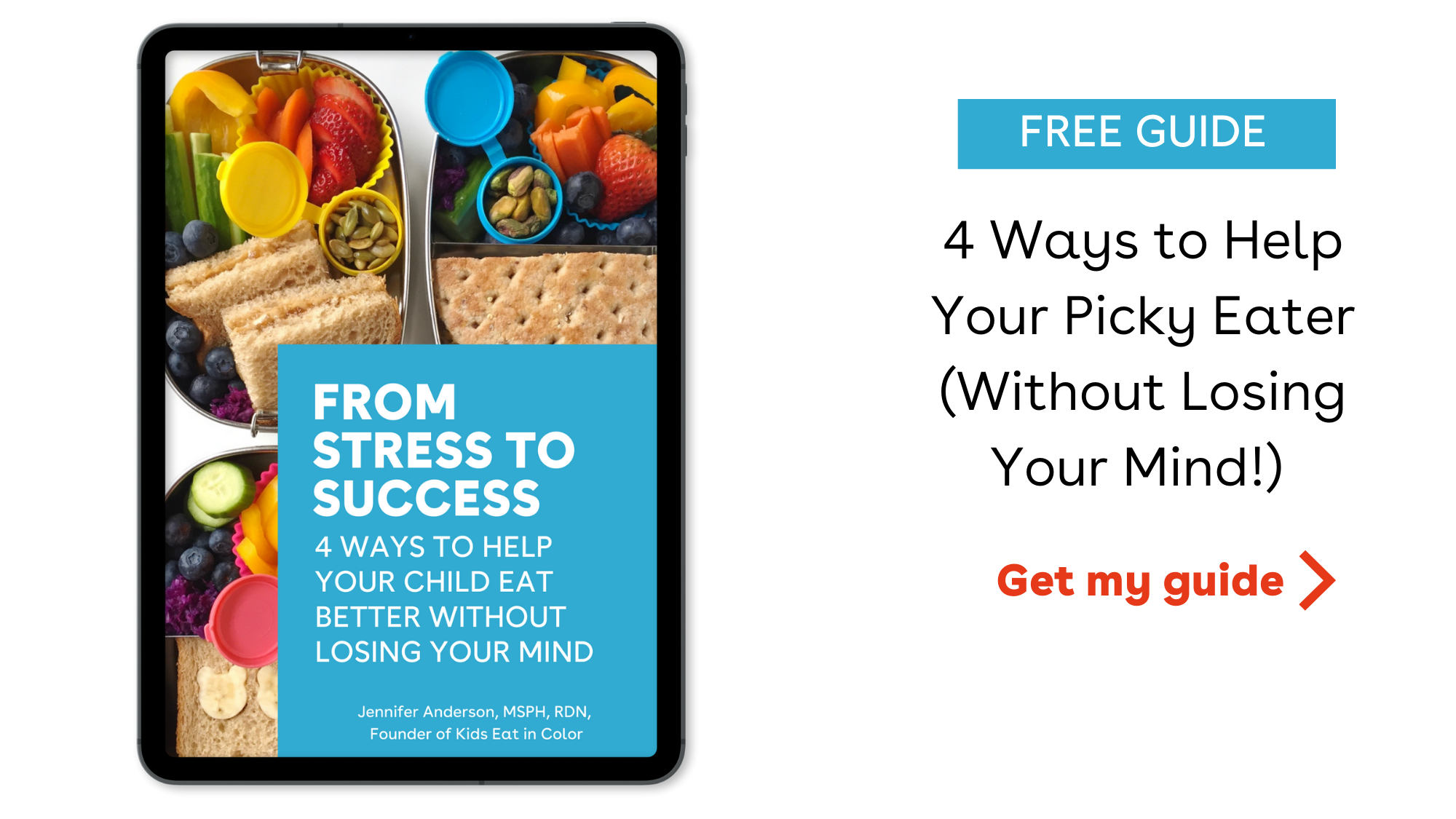Inside: Learn how food marketing and diet culture affect children, and find out what you can do to counter and limit your child’s exposure.
Recently, I walked by a soda machine with my two kids and their friends. They stopped and started talking about soda, I listened in.
Soda machines can be a huge fascination for kids. Even if they have had soda and know they like it, huge soda machines can make soda that much more fascinating.
In this instant, the kids were talking about their favorite kinds and what they had tried before. Right in the middle of the machine was a big sticker that said “Calories count. Check then choose.”
Food marketing and diet culture were influencing my children while I watched.
Soda machines are a form of food marketing. Food marketing (and diet culture) is everywhere and kids soak it up. Even if we work hard to limit their exposure to media, they will still be exposed to food marketing.
The problem with the “calories count” message
The words “calories count” on this soda machine communicated the message that calories are important. The words are in the biggest font (other than the brand name), drawing attention to them. This is also a message that introduces them to the idea of calorie counting.
Calories, in and of themselves, are not interesting. A “calorie” is just a measure of energy. The reason thinking about them is problematic is because they are associated with weight gain and weight loss. We wouldn’t care about “calories” outside of a culture obsessed with thinness and weight loss to become thin.
Why nutritionis important for children
One reason nutritionis important for young children is because it gives children a way of categorizing and understanding the world, before they encounter messages like “calories count.”
In my family, this began when my oldest was in kindergarten and was learning to read. He read the word “calories” on a nutrition label and asked what it meant. I told him, “Calories are a way to measure energy. It’s like the number of ‘energies’ in food.”
For the previous few years, we had already established that “energy” is what allows us to be able to move, grow and play. So, telling him that there are amounts of energy in food was something he could understand.
My hope is that the messages we tell them will help them see calories in a more neutral light and when they read “calories count,” they say to themselves, “Of course they count. They are what give me my energy!”
The problem with the “check then choose” message
Right below the “calories count” language, the sign on the soda machine read, “Check then choose.” This is an important marketing tactic. “Check then choose” is saying consuming soda is ALL a personal choice. You check the calories. You choose whether you want to eat a certain number of calories. You choose whether this affects your body in some way.
Food industries like alcohol, fast food, tobacco, soda, dairy and others use this marketing tactic. It protects their industries. When consumption is entirely up to the choices of you and I, they have no responsibility if there are health consequences to individuals or communities.
How advertising and marketing impact kids
Advertising and marketing leads to kids drinking and eating more of the product they see advertised than they would typically want to on their own. (1,2) The research supporting this fact is strong. It’s not all an individual choice when companies know they can influence you so strongly with their advertising strategies that you will purchase and consume a product.
This is the problem. It’s not that the foods are inherently bad or that we should tell children the foods are bad. By communicating a strict “good food” and “bad food” mentality to children, we can make their relationship with food complicated. When that’s mixed with the diet culture messages that your child will hear, it can lead to disordered eating and sometimes contribute to eating disorders. Plus, the food industry uses the “forbidden fruit” effect to get kids, especially adolescents, to want to buy foods their parents say are bad as well!
Food companies spend billions of dollars on advertising and marketing to make people buy and eat more than they would have. These foods often crowd out a wider variety of foods, which contribute to the problem of children in the U.S. not getting enough of some essential nutrients.
Soda companies can influence kids
Soda companies pay schools, like the one where we saw this machine, for the right to be the only brand allowed to sell beverages on campus. Not only does it ensure their revenue, but by pairing it with important experiences such as college sporting events, summer fun at the pool, or other meaningful interactions at school, it gives people a positive emotion toward the brand. This will make people buy more and like this brand more than other brands.
Soda companies do this in other ways as well, affecting younger children. They fund little leagues, warm, fuzzy commercials, and community initiatives. The purpose is for kids and their parents to build positive emotion toward the brand from the earliest ages. Food industries know that they can powerfully influence what you buy and eat by influencing your emotions.
It’s not all personal choice. Food companies spend $2 billion annually (not exaggerating) marketing to children alone. It’s because they can create demand that would not have been there for various food products and ensure their revenues.
What parents can do
According to the research we have now, there are a few things that we can do to counter the effects of food marketing to children.
Navigate their feelings
The most important one is to help your child feel negative feelings toward food brands, not the foods. (3) When a child has a degree of negative emotion toward a company, it is easier for them to decide if they really want the thing. They are less likely to be manipulated into buying more than they would have.
“Food companies try to trick us…”
Limit exposure
Another strategy is to limit a child’s exposure to food marketing.
Here are just a few sneaky ways food marketing reaches children:
- Celebrity endorsements on TV (even in movies), the radio or social media.
- Soda/snack machines.
- Any branded ads on social media, apps or their favorite games.
- Packaging.
- Popular cartoon characters on food packaging.
- School fundraisers.
- School sports jerseys or gear.
Food marketing is a tricky thing to navigate! On the one hand, we want to help our children have a good relationship with their body and with food. We don’t want the food industry to be able to manipulate their purchases through diet culture messages. We don’t want to give kids a complex about eating either, making their relationship with food complicated and feeding disordered eating! Additionally, we don’t want the food industry creating a demand for products that our children would not have had, potentially affecting their health.
There are no easy answers, but trying strategies that make sense to us is a good way to get started. It’s not fair to our children or our communities to just let the food industry off the hook for the damage they are causing to health and families’ finances.
References
1. https://pubmed.ncbi.nlm.nih.gov/37501119/
2. https://pubmed.ncbi.nlm.nih.gov/37668464/
3. https://spssi.onlinelibrary.wiley.com/doi/abs/10.1111/j.1751-2409.2009.01015.x




